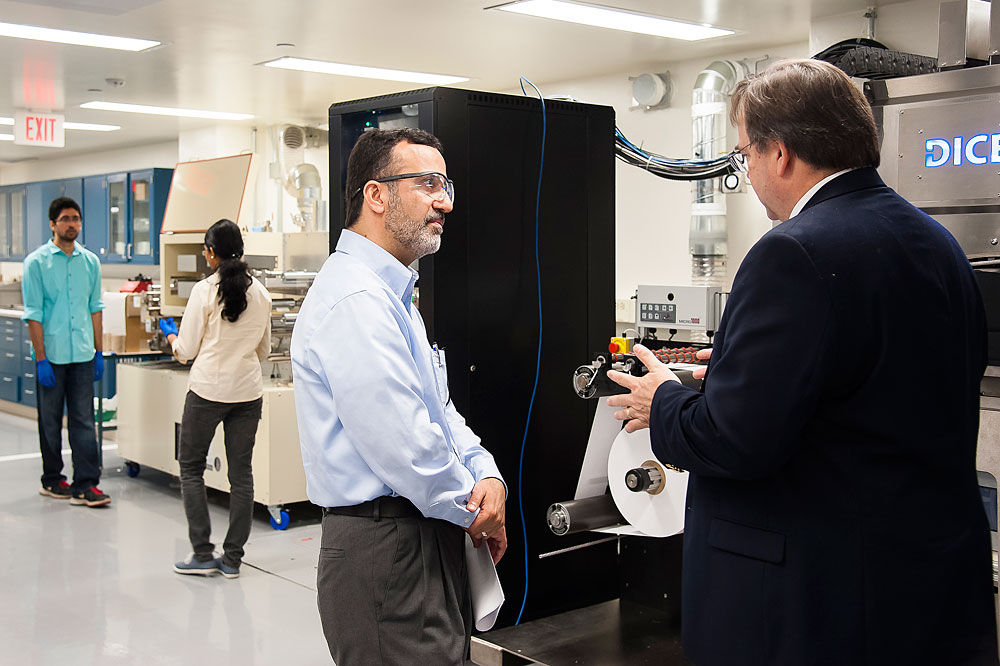Purdue part of team on $171 million flexible hybrid electronics manufacturing initiative
Purdue part of team on $171 million flexible hybrid electronics manufacturing initiative
| Magazine Section: | Breaking News |
|---|---|
| Article Type: | Feature |
Researchers at Purdue University and Indiana University Purdue University, Indianapolis (IUPUI) are partnering with global industry leaders in the Midwest and the state of Indiana as part of a $171 million federal initiative to advance research and manufacturing in the field of flexible hybrid electronics.
Purdue researchers will lead a $13 million component of the five-year U.S. Department of Defense effort to launch the Flexible Hybrid Electronics Manufacturing Innovation Institute (FHE MII), which will focus on the design, manufacturing and integration of electronics and sensors. It also will examine assembly and test automation for using complex flexible hybrid electronics on non-traditional conformal, bendable, stretchable and foldable substrates.
“This public-private partnership represents the ideal mix of industry and university researchers working together to create jobs, strengthen the economy and potentially benefit a wide array of markets,” says Purdue President Mitch Daniels. “The spinoff benefits to students also will be substantial by providing research opportunities to prepare them for careers in the increasingly competitive global marketplace that demands highly skilled people.”
Flexible hybrid electronics, an emerging manufacturing capability, enables the integration of thin silicon electronic devices, sensing elements, communications and power on non-traditional flexible substrates. These could include flexible glass, plastic, paper — even the human skin — and are used in everything from wristwatches, video displays and other communication components to medical prosthetics, robotics and sensors.
The Purdue-IUPUI team, led by Ali Shakouri, the Mary Jo and Robert L. Kirk Director of Birck Nanotechnology Center and professor of electrical and computer engineering, will focus on applying flexible hybrid electronics in pharmaceuticals, or smart pills, sensors used in food packaging or agriculture, and smart wound dressings.
Key industry partners include Eli Lilly & Co., Roche Diagnostics USA, Molex Inc., IMA Life, Landauer, Smith & Nephew, Kimball Electronics and Samsung. Another key partner is the Battery Innovation Center, adjacent to the Naval Surface Warfare Center in Crane, Indiana.
Through Purdue’s strengths in roll-to-roll nanomanufacturing, the team will examine how to enable low-cost fabrication for those applications. In addition, research will focus on inkjet/pulsed laser processing and printable nano-ink synthesis, flash light curing and sintering systems. It also will study low-frequency RF plasma chemical vapor deposition for graphitic materials such as flexible connectors, super-capacitors and glucose sensors.
The Indiana effort will focus on advancing new nano-inks synthesized at IUPUI that will be used in roll-to-roll manufacturing systems at Purdue.
“While hundreds of commercial products rely on smart sensors, there remains a question of scale and cost," says Shakouri. “Nanomanufacturing techniques don’t support mass-scale production because of the difficulty in fabricating a large number of smart devices repeatedly and under precisely controlled conditions. Moreover, nanomanufacturing involves several processes and a high level of integration.”
Shakouri has established strong ties with industry leaders that see promise in flexible hybrid electronics through Purdue’s recently launched Printing SMART Film Initiative.
That initiative, which has tapped 24 faculty members across 10 Purdue schools, is developing economical printing and manufacturing methods for these aware-responsive films, which can record data and provide real-time feedback. Smart films have applications in pharmacy, agriculture, food packaging and functional non-woven materials used for wound dressings and diapers.
Using a new Birck laboratory for roll-to-roll manufacturing completed in early 2015, the SMART film manufacturing techniques also include custom-designed roll-to-roll systems and functional printing.
“This national effort builds on Purdue’s engineering strengths as we pursue advances as part of a broader nanomanufacturing initiative at Birck where we focus on roll-to-roll production of smart thin films for applications in pharmacy and agriculture,” Shakouri says.
Purdue is already a part of two of the five previously announced NNMI institutes:
-
In January, the U.S. Department of Energy selected a team that included Purdue to lead the $270 million Institute for Advanced Composites Manufacturing Innovation (IACMI) to develop the next generation of energy-efficient vehicles and wind energy and compressed gas storage technologies. Purdue will serve as home to the Indiana Manufacturing Institute, a $50 million facility now under construction at the Purdue Research Park for advancing research on composite materials that could have a significant impact in many industries such as aerospace, aviation, automotive, energy and sporting equipment.
- In February 2014, Purdue joined a team led by Chicago’s UI Labs for the launch of the $320 million Digital Lab for Manufacturing, a Department of Defense project focused on digital manufacturing and the application of computing, sensing and data analytics to improve manufacturing machines and factories. Purdue is leading the application of 3-D modeling and enterprise interoperability standards for data exchange among companies within the Department of Defense supply chain. Purdue also is developing best practices for the use of 3-D modeling throughout a product supply chain.
